December’s here again. There are two things to be happy about this month – Santa’s coming and the good weather is finally upon us. We can chat about Santa later, for now let’s praise the weather gods and see what we can get up to. The wet months have well and truly passed us by. Animals in pairs and old men with super long grey beards can relax... the giant wooden boat cruise is cancelled.
We have experienced insane precipitation levels and late season snow melt run offs that have filled water catchments and scoured out our river systems. While some of the upper reaches will take time to repair the environments fish love to haunt, the lower reaches have had a much welcomed flush. The sun has come out to play and the heat it sends down is very warmly received – see what I did there? November had a couple of cold snaps, where it forgot its end of the calendar, but December looks good to fire.
This is the month where everything comes on. Water temperatures have had a good little pop and the fresh water flowing out of the rivers has abated. This is a fancy word for slowed right up – it’s allowed the estuary systems to climb in salinity. High tides are now a thing of beauty with gorgeous, green and salty water rich in nutrients filling our waterways.
Why is this good news? Fish love it. All saltwater fish do. The species filling the bottom reaches of our rivers and estuaries are many and varied. Staples such as Australian Salmon and flathead have thickened right up. Bream, couta and gar are hungry and on the move. Even the elusive snapper and yellowtail kingfish will become key targets for the December angler. Bear with me while we have a quick whip around the state to see where you can wet a line between BBQ events this month.
The North West Coast sees a great deal of action on the water through December, due in part to the improved fishing, but just as much to the weather. The coastal areas are open to winds from the west, all the way round to the east and don’t have a great deal of cliffs or headlands to use, to even escape any wind from the south. Excluding the immediate areas around the Nut, Table Cape and the Don Heads. Normally, three or four nice days in a row of calm weather, or a cracking weekend, remind everyone that… ‘Oh, hang on – I’ve got a boat.’ This startling recollection always sees a great deal of watercraft activity off the coast.
Wynyard at this time of year is always worth a look for some quality flathead. I start in close at around 30m of water and set a drift going. If you have a few on the boat, mix up what you’re presenting to the target species. One paternoster can have pilchards as bait with a good old fashioned red and white popper tied off to the sinker snap. The other can have squid as bait with a big paddle-tail plastic tied off to the sinker snap. A big free flowing paddle-tail like Berkley’s Nemesis is just the ticket. Anything that flutters in the water as you drift can be crucial in getting the bite.
If you’re not getting any interest in 5-10 minutes, move a little further out and try again. When you pick up a few nibbles or get some keepers, put a waypoint in your sounder – it’s a lot of money sitting on the dash of your boat. Put it to work! If the bite slows right off, fire up the boat and go back to start another drift slightly up from your last run. Any bites or fish taken – add some more waypoints and repeat. You’ll find after a while that you’ve created a little map that gives you some insight as to where to start next time you’re out.
If the weather is really good, you might want to set up a gummy rod. If you set this rod up with 40lb leader to a swivel and running sinker, you may even find a snapper lurking – that will warrant a waypoint. The rig I use is simple and effective. Braid line is on most of our reels for this purpose, but mono is fine. I thread one of the Ezi rig clips onto the braid first and then tie on a mid-sized swivel with the Pitzen knot. Again with the Pitzen knot, tie a metre or so of 50lb fluorocarbon leader, thread on a lumo bead and tie on a 4/0-5/0 Owner circle hook. That’s right, with the Pitzen.
Going back to the ezi rig – these are great, as you can run a decent sized ball sinker up the braided line. Braid hates to be chafed and it may not be an issue on the first or second outing, but when you lose a big gummy boat side as it rolls like a salt water crocodile, it’s sure to effect blood pressure, especially if it’s found to have been braid chafe at the swivel’s fault. When trying to fish hard on the bottom, it can pay to remove the stainless clip from the ezy rig and tie sinker on with a 20lb mono break away. This negates any major issues if a snag is encountered.
Squid is the bait of choice, as it will withstand any pickers the bait may encounter while it soaks, waiting for a gummy to smell it and chomp. You can use strips of fish or whole pilchards. Some of the BaitMate product is handy when rigging baits on circle hooks. It’s very important to not clutter the hook gape. That gape needs to be open and clear for the circle hook principle to work.
While you may have carefully put the bait on the hook, by the time you lower it down and it gets a few nibbles, it can slip down the hook shaft and jam up the gape. BaitMate is a dream product to stop this from happening. It’s basically some light stretchy thread that absorbs odour and juice to become next to invisible on baits. Gummys are one species of fish that can sensational to target at anchor, but we’ll talk more about that later.
These tactics for flathead and gummy sharks will work off the coast in areas like Somerset and Burnie. Ulverstone can hold fantastic flathead and gummy sharks to the west of the river mouth in 30-45m of water, as can Turners Beach and the ground right through to Port Sorrel. There are several angling opportunities that will arise from a day flathead fishing of the North West Coast, so it pays to be prepared.
You may encounter Australian salmon and squid at any time. Having a designated rod set up and ready to go is better than fumbling around with the bottom fishing gear. The bottom fishing outfits will be too heavy in the rod weight and often the braid or mono is around 20lb or more. That’s where a designated 4-6kg 6’6 to 7ft squid jig and salmon lure rod is perfect. Marry that to a 3000-4000 size reel – you can even run some heavy jigheads and soft plastics for snapper and kings if they turn up.
Fishing can be a matter of moments. There can be nothing going on and then it all happens at once. Then the moment is gone. That’s why having a rod sitting with a squid jig or lure rigged is worth its weight in gold at times. You can have a huge squid follow a bait or caught flathead up and it’s action stations. It’s perfect if you can lean over, grab the go to rod, trip the bail arm and plop the jig over. Jig, jig – boom! Calamari. No one has got time for ‘Quick, quick do this! Get this! Tie this on! Dang, where did the squid go?’
The big question this summer is not ‘Why should I fit an electric anchor drum winch to my boat?’ In recent years I’ve had the chance to use boats that lower and raise the dreaded anchor with the flick of a switch. I say dreaded, as it’s a major pain in the butt to lower and raise an anchor manually. You may think that lowering is just a simple matter of dropping it off the bow. I’ve drawn the short straw to be anchor boy over the years – when you make your way to the bow, which can often be a wild adventure in itself, you will often find an unholy mess. Out of site and out of mind, the rope and anchor have bounced and flip flopped in the well tangling badly.
In a fishing sense, this is just a time frame thing where you can sit and untangle and sort out. In a safety situation where you have to deploy the anchor, you don’t have that time. Here we have the two main uses of the anchor – safety and fishing. The electric drum winch is a no brainer when it comes to safety and ease of deployment in a quick-response situation. Seconds can be crucial if your pride and joy, and loved ones, are drifting onto the rocks or into a wave zone.
On a lighter note, an electric drum winch opens up some amazing fishing. We’ve grown up with the idea that to catch our staple species of flathead and squid, we must be on the drift. For the most part that’s correct, but there’s a whole new world out there for the angler willing to anchor. Snapper, whiting and yellowtail kingfish all respond well to sitting on the pick and getting a berley trail going. Gummy sharks and bigger flathead will also get motivated and move in on a substantiated berley trail. The process becomes much, much simpler, without any of the pain associated with lowering and raising an anchor by hand.
When you have the anchor and chain running out, just tap in and out of reverse to lay back off the anchor a little. The depth will determine how much rope to let out, but for fishing needs, get in your head that you’ll need at least double depth. This is just a guide – there’s a whole heap of things to consider when using your anchor to hold bottom overnight.
You should now be holding bottom and slowly coming back on the anchor with the stern of the boat perched above the area you’ve chosen. If not, and here is the absolute god send, you just let out more line or raise the anchor and start again – all with the flick of a switch. No one has had to go out round the cab or trample over gear to get to the front hatch. No one has to risk their fingers in and around the anchor rope that looks like tossed spaghetti. It’s effortless and brings a whole new dimension to your vessel – old or new, small or large.
As a chap who is often out with kids or people new to our great pastime of fishing, I can say there’s another gem to a boat fitted with an electric drum winch – lunch. It’s so damn good as a skipper on a boat, to be able to pull up in a nice bay or in behind a headland, and drop anchor for lunch. You can relax with the rest of the crew, enjoy a bite to eat and the excited banter from the kids about the awesome day they’re having in peace. You won’t worry about drifting into other boats or rocks or lake trees and shallows. It’s awesome.
I’d like to introduce a mad keen, southern fisher – Justin Rossiter. Justin has kindly tested his local knowledge of the southern waterways and put some information down for you all. December is the first month of summer and we should see the annoying winds of spring start to drop out and settle. This will allow anglers a greater opportunity to get on the water or fish from their favourite spot on terra firma. Anglers in December will be keen to catch a feed, and also eyeing off tackle store goodies with a view to waking up on the 25th, to a bit of new gear under the tree.
In the southern region, we’ve enjoyed one of the best southern bluefin tuna seasons in memory. For southern offshore anglers, we’ll be turning an eye towards another Tassie favourite – the striped trumpeter. Tassie trumpeter, or stripey, is a prized table fish and found over reef areas from 25-300m deep. The good news for those that want to target them, or like to eat them, is they are scattered around the entire southern coastline.
Attention will turn to water temperatures and, when it starts to warm, the hard-fighting mako shark. The undisputed key word when targeting mako sharks is berley, and lots of it. If the seasonal increase in water temperature along the East Coast of Tasmania continues as it has done in recent years, we could expect some early surprises. In turn, it would be no surprise to also see a host of unusual captures offshore, as more anglers get excited and start to venture out. After a mahimahi was caught in the middle of winter off the South Coast last year, anything’s possible!
For those looking forward to some well-earned down time with family and friends, this month’s weather will offer more chances to get on the water. December will see all of the usual suspects start to fire. The humble flathead (sand and tiger) will move into shallow water to spawn and can be caught from beach, boat or jetty in water of 2m+. These fish will provide lots of fun and food for the family. Flathead are aggressive at this time of year and take soft plastics, micro jigs, trolled hardbody lures and just about any bait you care to mention. I can’t go past a paternoster rig with circle hooks and a strip of squid, or a small piece of sand whiting.
Calamari will be moving into all areas in the south and can be targeted from a multitude of jetties and land-based spots, as well from the boat. The land-based angler is often forgotten in the world of fishing, but Southern Tasmania caters for them very well. The many bays and sheltered areas have wide and varied locations for the land-based fishos to try their luck. The key is to look for broken motley bottom or sea grass beds. Use quality jigs in size 2.5 to 3.5 – squid jigs come in a bewildering array of colours and patterns, but use one with a red foil underneath and a natural colour over the top. And beware of the ink! Chasing squid, it’s a good idea to not wear that new polo shirt that Nanna brought you for Christmas!
Australian salmon will provide plenty of light line action for anglers of all ages and can be found around nearly every rocky point in Southern Tasmania. Casting a metal slice or soft plastic lure from the rocks around Bellerive Bluff or under the Tasman Bridge should provide plenty of action and possible a kingfish. For those out in the boat, trolling around any rocky point on the way out for a day’s fishing may produce some nice fresh bait or a feed of salmon patties.
Kingfish are now a very viable summer target in southern waters. In previous years, kingfish were seen as a rare by-catch, but last summer the captures soared and many anglers now specifically target these tough fighting fish. Kingfish can be targeted in North West Bay, the bottom end of the D’Entrecasteaux Channel, Derwent Estuary, Storm Bay and Frederick Henry Bay, to name a few. If a school of kingfish appear, put the light bream gear away and bring out the heavy artillery.
Speaking of bream, the Derwent River is home to some thumping specimens that will hopefully start to fire this month. The above average rainfall has made it tough going into the Derwent. The river resembled chocolate milk for the last month or so. Casting small hardbody lures around the rocky shores and points with a dead slow retrieve will give you the best hope of landing a trophy fish. Small soft plastics in a natural baitfish colour on light weighted jigheads will also have you in the game.
December should see the first early licks of the East Australian Current start to push down the coast. Albacore tuna is what we’re keeping an ear to the ground for here. Albacore tuna are fun to catch, easy to catch and very tasty. The 100m line is the best place to put the lures out and start looking for them all the way out to the shelf. In a weird animal kingdom setup, big schools of smaller albacore are often found early along the coast from Eddystone Point and on down to Bicheno. They start to get bigger as the season goes on, but the thumpers are found down south around the Hippolyte Rocks and out across the grounds east of the shelf.
Albacore tuna are aggressive and love a skirted or feather lure. Pink and Purple Zuker lures with a hint of white bring a lot of them undone. The green and yellow one is a standout as well. Albacore have good eyes and may well see colour contrast – that’s what draws them in. Once you get a strike, get a waypoint down and do a figure eight around that mark. This can often lead to more and more strikes. If you fall off the fish and loose them, circle a long arc to the south and look for them again. The current is running north to south, so going down south and coming back up can find them again.
These fish taste awesome and are simple to prepare. They need to be bled. Have some ice on board to make an ice slurry in the esky, as this will keep the fillets in very good order. They don’t need massive overhead rods and massive line classes to catch. They’re great fun on light gear and you can successfully target them on mid-large size eggbeater reels.
With the warm currents come some very interesting fish species. While December is a little early, it’s worth talking about yellowtail kingfish. These fish have a mystique around them, for good reason. When hooked, they go hard – real hard. When they get around 5kg and better, they have sensational power. They’re the diesel engine of the fish world. The other thing in their favour is they eat well, both as sashimi and also cooked up. To a degree, some of the allure from the difficulty in catching them, and they’re relatively uncommon. They were, at least.
The last few seasons have found kingfish in our waters in good numbers. Those who set up to target them and give their fishing a little tweak are doing well. It seems that success is greater when fishing around structure. That structure can be of the Mother Nature or artificial variety – rocky points with a deeper channel, a wharf into deeper water or in and around boat moorings. These are all areas that will hold fish. Evidently, these fish can be as fussy and finicky as any. They become more aggressive around strong tide flow or water movement around the extremes of the tide. Bigger soft plastics with a long tail and a heap of action are the go. Bait fishers will have success with squid tentacles or a whole fresh squid under a float.
Nearly every year, mako sharks are the first to be encountered off the shelf of the East Coast. A great many holiday goers flock to the coastal town of St Helens and fish the depths for some bottom dwellers, like blue-eye and gemfish. The action up and down from the sea floor 400m below creates a bit of attention. The clear water off the shelf allows fish to see for a great distance and three blue-eye heading to the surface is like a red rag to a bull. Incidental run ins with a good organised crew will land a mako, as will anglers that target them.
December will see some weather windows that will allow a good amount of berley time. This is what it’s all about with early mako sharks – berley and the time you can have it in the water. Sharks will thicken up as the month wears on into January and come to the boat quickly. Allow yourself a minimum of four hours to berley, but 6-8 hours is optimal.
Trout will be in top gear this month. The constant warmer climate will have everything hatching and popping out of a cocoon, or becoming the winged version of itself. Duns and spinner fishing will be completely off tap. Making sure your presentations are well tied, as there will be so many real life ones on the water surface that your fake one will want to be the best. Midge hatches at dawn provide cracker fishing, but trout can be fickle at times. On a good hatch, the fish are spoilt for choice.
The rivers around the entire state have been fishing superbly and this is set to continue. Water flows will start to slow down, so deep holes and backwaters will be the places to try. Soft plastics will work and entice – a slow roll will be deadly. The 2.5” PowerBaits are amazing – these little beauties get a tail flutter going on a super slow handle turn and will roll their shoulders from left to right as well. They have really performed well this season. The ability to provide an irresistible action on a slow roll of the reel handle is crucial and leaves a soft bait in the strike zone for longer. The longer you can be in the zone and entice a hunger or territorial bite, the better.
The same can be said for hardbodies. Working out where the fish are and getting a lure to get in, and stay in front of, for as long as you can. The modern hardbody lures can be expensive but the work that goes into them allows a twitch-twitch, rod draw and wind technique that helps them to work at a slower retrieve. If you’ve covered a patch of water and that hasn’t worked, pick the pace up for another fan of casts and move on.
There’s a belief that Christmas is about giving and being with the family – rubbish. We all know that Christmas is about getting new tackle as presents and dropping a heap of hints about what you’re low on or could do with more of. December is the month to start early and come on like a broken record. Around the dinner table is best, or in the captive audience of a car journey. Just whimsically go on about how you lost your favourite Cranka Crab or the tackle box is looking a little sad and could do with a top up. Make it known that the fly rod you have is getting a little long in the tooth and the new Demon Smuggler from Hardy is just the thing you need.
Don’t forget to also drop hints about gift cards, if you don’t think your loved ones can be trusted to get it right. There’s nothing worse on Christmas morning in Tasmania than opening a heap of presents filled with Murray cod lures and bass surface lures. If you have a partner in crime (a young son or daughter who loves to come fishing with you), put them to work. They can be used as a double agent and manoeuvre your loved ones to the right gear and tackle store.
In all seriousness, have a great Christmas and New Year. It’s the season of goodwill – carry that forward to 2017 and travel safe. Until next year, tight lines!
Reads: 2812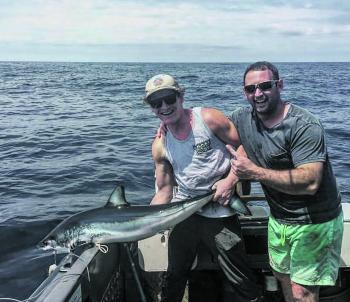
Early season mako can be small, but no less tasty.

Freya Rossiter enjoying a sunny day looking for flathead.
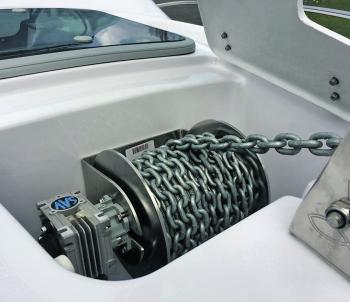
An electric drum winch is a considerable value-add to any vessel. This install by SAVWINCH shows how clean and easy they are.
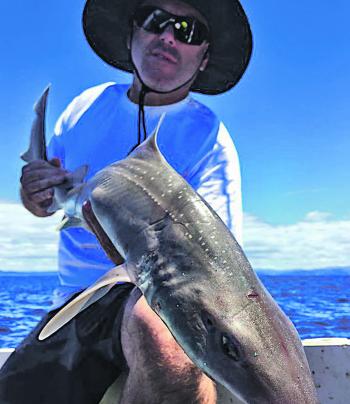
Mark enjoying the fruits of his labour.
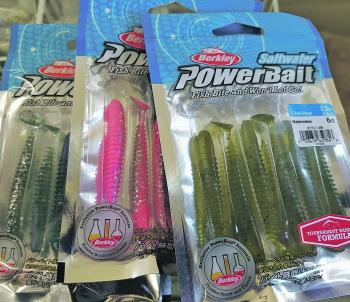
Don’t be fooled by the Saltwater label. These things are deadly on trout.
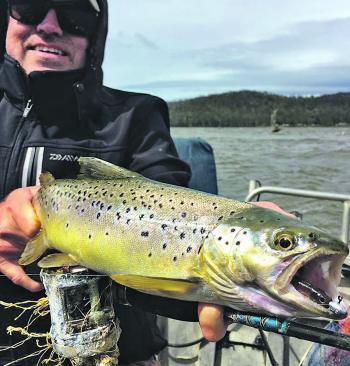
Don Cummings came across from Sydney to sample some trout action. His gear left a little bit to be desired.

Clea with an awesome summer flathead that’s sure to be tasty.
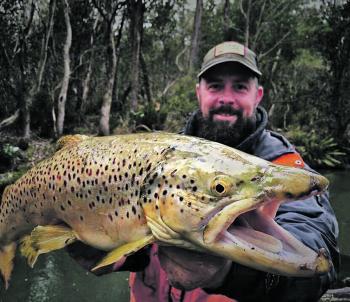
Ben Hoggins with a buck brown trout – that should be a great memory!
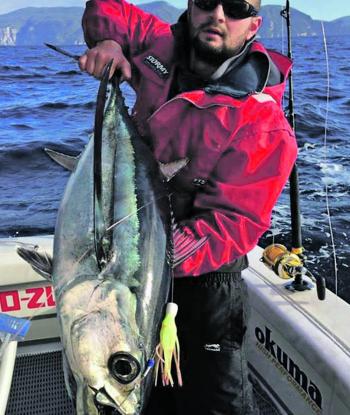
Jack Guard with a solid Tasmanian albacore.




